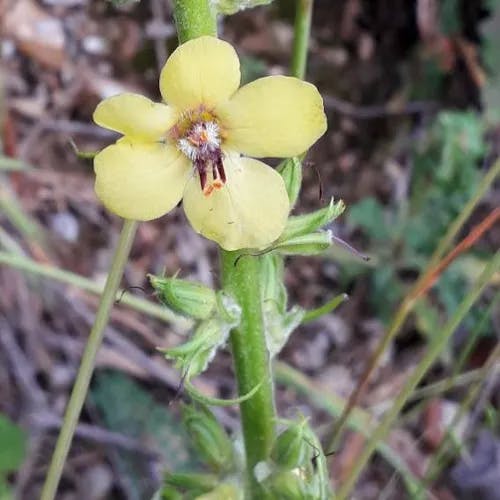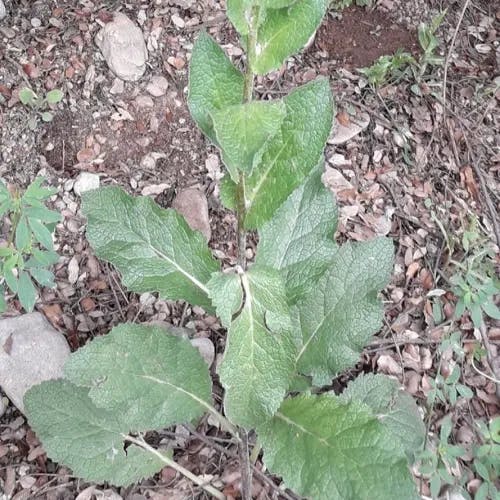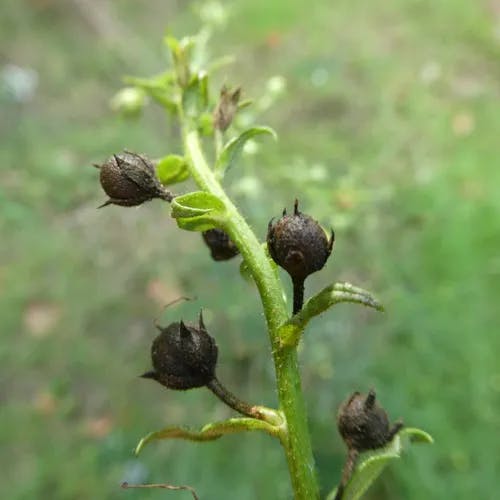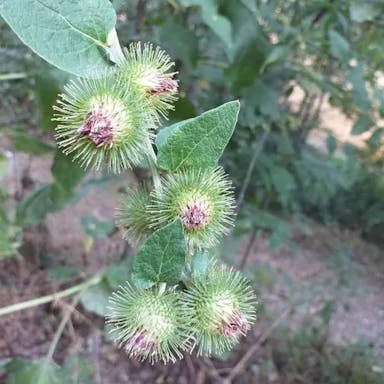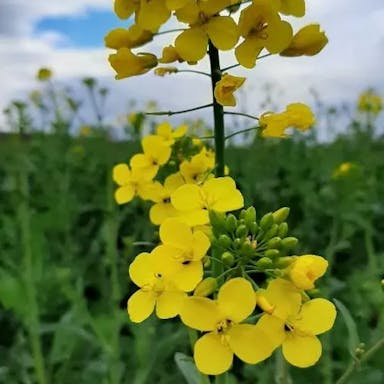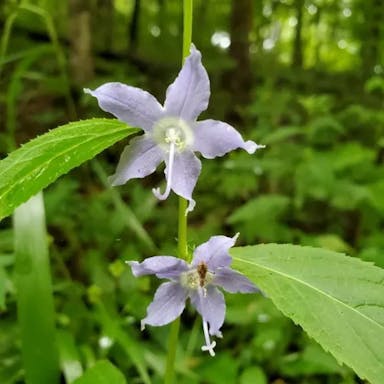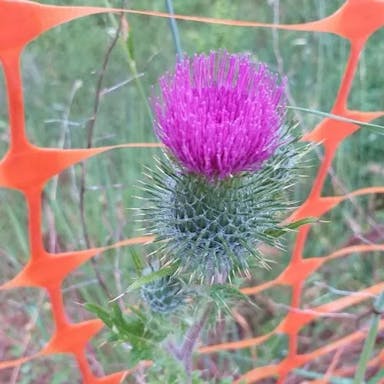Moth mullein, scientifically known as Verbascum blattaria, is a plant that belongs to the family Scrophulariaceae. It is indigenous to Europe and Asia, and has been presented to North America. The being is a biyearly or ephemeral evergreen, sprouting up to 1.5 meters elevated. It has a basal rosette of foliage in the freshman annum, followed by a lofty efflorescence stem in the sophic year. The florets are ordered in a compact spike, with each floret having quintet petals. The chromaticity of the florets can be variable, but they are typically achromic or wan aureate with amaranthine or brown markings. The florets are pollinated by nocturnal lepidopterans, hence the frequent designation
Moth mullein
- Common name
- Moth Mullein
- Scientific name
- Verbascum blattaria
Basic Information
- Scrophulariaceae Family Verbascum Genus Moth mullein Species
- Scrophulariaceae > Verbascum > Verbascum blattaria
- 83%
- The Completeness of This Encyclopedia
Please help us complete the encyclopedia, Terrarium is a encyclopedia service to be completed with everyone in the world. Currently, this page is 83% complete. For more information on how to contribute, please click here.
- Biennial
- Forb/herb
- Height
- 60cm ~ 120cm
- Flower Color
- Leaf Color
- Anthesis
- summer
- Sunlight Exposure
Full Sun Long hours of sunlight from morning to afternoon Partial Shade A location in the shade of a tree or where either the morning or afternoon is shaded Full Shade A place where there is no direct sunlight
- Full Sun
- Hardiness Zones
This is an indicator to know to which zone each plant can winter. Knowing the zone of each plant gives you an idea of the cold temperature resistance when grown in the ground without a roof. 2: -42.7 to -40.0 3: -39.9 to -34.4 4: -34.3 to -28.9 5: -28.8 to -23.3 6: -23.2 to -17.8 7: -17.7 to -12.2 8: -12.1 to -6.7 9: -6.6 to -1.1 10: -1.0 to 4.4 11: 4.5 to 10.0
- 5-9
- Cold resistance
- Good
- Heat resistance
- Fair
- Habitat of origin
- Europe
- Growth Rate
- Normal
What is Moth mullein (Verbascum blattaria)?
What is Moth mullein (Verbascum blattaria)
Flower meaning
The moth mullein flower language commonly used in the United States represents graceful departure or farewell. This flower is often associated with saying goodbye or farewell to someone. Moth mullein is commonly used in funeral flower arrangements. For example, sending moth mullein to a friend moving away can express wishing them a graceful departure and feeling sad about their leaving. However, flower language meanings can vary by culture.
Calendar of Moth mullein (Verbascum blattaria)
Calendar
Moth mullein (Verbascum blattaria) is flowering plant. It grows in Europe and United States. The flowers start to bloom in late spring. They stay until early summer. June is when there are many flowers. It takes 4 to 6 weeks for all the flowers. The plant makes tall spikes with small, delicate flowers. To make it bloom longer, remove old flowers. This makes it make new flowers. Moth mullein needs full sun and drainage. It grows in meadows, along roads, disturbed areas.
How to grow Moth mullein (Verbascum blattaria)
Watering
Moth mullein, scientifically known as Verbascum blattaria, requires regular watering to thrive. The correct watering method involves deep soaking that reaches the roots. Avoid frequent overhead watering, which causes disease. Well-drained soil is ideal, allowing the top layer to dry between waterings. When dormant in winter, reduce water to once every few weeks. Proper watering allows beautiful blooming. In spring flowers start to open. Petals unfold gradually over days. Bright yellow attracts pollinators. Deadhead spent blooms to prolong flowering. Tall flower spikes stand above woolly leaves. Biennial plant with rosette first year. Taproot delves deep into soil. Originally from Europe and Asia. Naturalized in North America. Found along roadsides and fields. Tea made from leaves traditionally used for respiratory Problems. All parts poisonous if ingested. Larval host for some moths.
Soil and Fertilizer
Moth mullein, scientifically known as Verbascum blattaria, thrives in well-drained soil with a pH range of 6.0 to 7.5. It prefers sandy or loamy soil that is rich in organic matter. The plant requires full sun exposure for optimal growth. A balanced fertilizer supplies the necessary nutrients. Apply the fertilizer in early spring before the growing season begins, using 1 lb per 100 sq ft of planting area. During the growing season, you can apply more fertilizer every 4 to 6 weeks, following the same dosage. Be sure to water the plant thoroughly after fertilizing for proper nutrient absorption. Check the soil regularly to monitor the pH and nutrient levels. Make adjustments as needed to maintain ideal soil conditions. Always follow the manufacturer's instructions when applying fertilizers. Protective gear is recommended.
Sunlight and Place
Moth mullein, scientifically known as Verbascum blattaria, is a plant that thrives in full sun exposure. Flowers bloom in summer, creating many seeds. The mullein enjoys good drainage and plenty of sunshine. It withstands cold winters and hot summers. The plant grows in different types of soil across a wide region. Overall, mullein is a hardy plant that can live through different temperatures and requires much sunlight for best growth.
Advanced Information of Moth mullein (Verbascum blattaria)
Pruning
Moth mullein, scientifically known as Verbascum blattaria, benefits from regular pruning and cutting back to maintain its health and appearance. Flowering has finished at the base. Next, thin out crowded areas by cutting back some of the older stems to the ground. This will encourage the growth of new shoots and improve air circulation within the plant. After pruning, it is important to clean up the area by removing any debris or fallen leaves. Additionally, consider applying a layer of mulch around the base of the plant to conserve moisture and suppress weed growth. Regular pruning and cutting back of Moth mullein will help maintain its overall health, shape, and vigor.
Planting and Harvest
Moth mullein, scientifically known as Verbascum blattaria, is a plant that can be potted or planted in the ground. If growing in a container, select a pot with drainage holes. Fill with a soilless potting mix and place the plant inside. Water thoroughly after planting. Situate in an area receiving full sun. To grow in the landscape, choose a site with well-drained soil and all-day light. Dig a hole and set the plant at the same level as the surrounding ground. Backfill the hole and water well. Continue to irrigate during dry periods. When the plant becomes too large for its pot, repot into a slightly bigger container using fresh potting soil. Poor care leads to decline. For healthy growth, ensure proper light, moisture, and drainage.
Propagation
Moth mullein may be increased via altering techniques like putting seeds, bifurcating the roots, making cuttings, and using leaf cuttings. To increase via sowing seeds, mature seeds ought to be gathered then planted in soil with decent drainage and sunlight. Keep the dirt moist until sprouting happens. To bifurcate, cautiously uncover the plant then divide the root clumps into tinier parts. Replant the divided sections in ready dirt, verifying each part has adequate roots and shoots. To make cuttings, take stem cuttings 4-6 inches long from vigorous plants then take away the lower leaves. Dip the cut end in rooting aid and embed it in a mix for drainage. Keep the dirt moist and supply indirect lighting until roots grow. Leaf cuttings can likewise be utilized to increase. Take sound leaves and put them in a plate with moist earth. Keep the dirt consistently wet and supply indirect light until new plants show up. Gathering might be done when the plant achieves development and the blossoms are completely created. Cut the stems simply over the ground level and utilize the reaped plant material as wanted.
Pests and Diseases
Moth mullein (Verbascum blattaria) is susceptible to several pests and diseases. An insect that can be a problem for this plant is the mullein moth. The young mullein moths eat the leaves, which can hurt the plant. To help stop the moths, you can look for eggs and young moths and remove them. Also, natural predators like tiny wasps can control the moths. Another pest is aphids. They are tiny bugs that suck sap from the plant. This can slow the plant's growth and turn leaves yellow. It can also spread diseases. To avoid aphids, check the plant often. If you find aphids, use a gentle soap spray or release predators like ladybugs. A fungal disease moth mullein gets is powdery mildew. It makes a white coating on leaves and flowers. To avoid it, make sure air moves around the plant. Don't water from above. Remove any diseased parts. You can also use antifungal sprays preventatively. If moth mullein starts to wilt, it could be from not enough water, poor nutrients, or root rot from overwatering. Proper watering, fertilizing, and drainage can prevent wilting.
Habitat of Moth mullein (Verbascum blattaria)
Habitat
Toxicity of Moth mullein (Verbascum blattaria)
Health Benefits
- edible
- Inedible
- Toxic
- No toxicity
NO DATA
Toxic for dogs and cats
NO DATA
Q&A of Moth mullein (Verbascum blattaria)
- What are the benefits of moth mullein?
Moth mullein, known as Verbascum blattaria, provides benefits. The plant serves in remedies for conditions like bronchitis and asthma. It acts as a food source, contributing to biodiversity. Its flowers make it popular for gardens. Though, it can become invasive lacking management.
- What are the uses of moth mullein?
Moth mullein, scientifically known as Verbascum blattaria, is primarily used for its attractive flowers. However, the plant is considered a weed in some regions. Its uncontrolled growth can negatively impact local ecosystems. Therefore, its use should be managed responsibly.
- Is there a recommended way to choose Moth mullein?
Moth mullein, scientifically known as Verbascum blattaria, is also a plant belonging to the Scrophulariaceae family. Choosing types of Moth mullein is important for traits and needs that each shows. The 'Album' one has white blooms and reaches almost 3 feet high. 'Roseum' features pink flowers and similar height. Also, 'Polar Summer' has large pure white flowers and compact growth. When buying seeds or seedlings of Moth mullein, selecting fresh, high quality ones is advised. Pick seeds that are plump and free of damage or odd color. Seedlings need healthy leaves and a strong root system. Carefully choosing types, seeds, and seedlings helps growing Moth mullein in your garden.
- How to grow moth mullein from seeds?
To propagate Moth Mullein (Verbascum blattaria) from seeds, start by dispersing the seeds straight into the place in late autumn or early springtime. Guarantee well-draining area gets complete Sunshine. Lightly cover the seeds. Water occasionally, but avoid drenching because overwatering induces decaying. After emergence, space seedlings for development. Moth Mullein is a biennial; anticipate blooms in year two.
